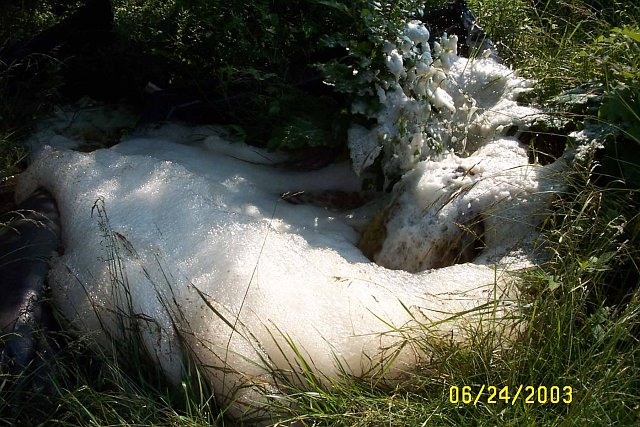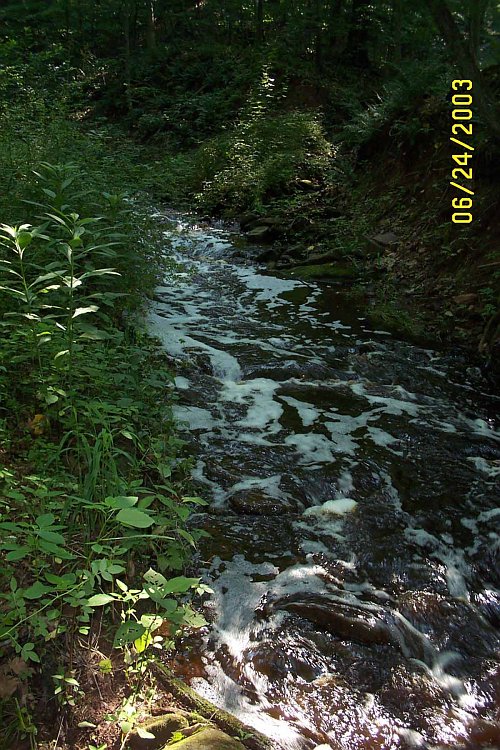

Foam in Sligo Creek - May 8, 2006
Piles of Foam? It's a natural phenomena! provided by Masaya Maeda of AWS
This morning on my way to work I noticed an abundance of foam on Sligo Creek in-between New Hampshire and Maple, it also went above that area. It was extremely unusual with foam as high as 2-3 feet. It looked as if someone dumped 5 gallons of soap in the stream.
She reported the foam to Montgomery County using their hotline 240-777-DUMP. Since the affected section of Sligo Creek is in Takoma Park, she also called Takoma Park Dept of Public Works, but got no answer.
Clair Garman, FoSC steward for the affected section 3, observed the large chunk of foam (4 feet tall) at the old waterworks just upstream from Maple Ave and drove to the nearby Takoma Park Dept of Public Works office to report the problem. Ali Khalilian, Takoma Park City Engineer, drove to the old waterworks to investigate the foam. Calls were made to Montgomery County and the State of Maryland. Mary Ann Lattin from Montgomery County and Mike Eckerd from Maryland Dept of Environment are investigating.
Chunks of foam were observed in the creek from Maple Ave to just downstream from the golf course upstream from Colesville Rd. A search upstream from that point to University Blvd yielded foam on the water, but no chunks. No obvious source of the foam could be found. It seemed to get worse further downstream, but there was no place at which the foam could be seen to begin.
Preliminary information indicates that the foam may be a naturally occurring phenomenom. Steve Martin from the county office told me by telephone that tannin and lignin dissolve as the rain flows into the stream. The tannin produces a dark, tea-like color to the water; the lignin produces foam. The water in the stream was dark and tea-lie today. More detail will be provided on this web page as it becomes available.

Photo by Clair Garman

Photo by Ali Khalilian

Photo by Clair Garman

Photo by Clair Garman

Photo by Clair Garman

Photo by Clair Garman
between Wayne Ave and Colesville Rd

Photo by Clair Garman

Photo by Clair Garman
Update from Montgomery County Department of Environmental Protection
The following was provided by Maryanne Lattin, Montgomery County DEP.DEP believes the foam we have been seeing in Sligo is naturally occurring. We are currently running a series of samples which will provides us with surfactant, nitrate and phosphate levels. Samples have been collected from Sligo during times of no foam, mild foam and, as we discussed, a sample was taken yesterday (high foam). We are currently in search of a lab that can process samples for lignin levels (a natural foaming agent).From tracking complaints, we have found that incidents of foam occur during times of high flow (rain events) and high agitation. I have attached photos from a previous case in which a retention pond at a compost facility was aerated; the result was excessive foam just as we have seen in Sligo.
"Natural" foaming occurs when small aquatic organisms (such as algae) die and decompose, releasing a variety of organic compounds. The tea colored water you described would indicate tannic acids in the water, which is a by-product of organic decomposition of vegetation. As wind or currents stir the water, foam is produced and can accumulate in quantities on windward shores or in eddies. The natural foam has a somewhat earthy or fishy aroma, and it breaks down rather quickly. Foam from silt or erosion is usually a dirty brown color. Foam is often seen in the early morning hours and is gone by midday. Detergent foam, by contrast, will have a noticeable perfumy smell from additives which give your wash that "rosegarden" or "lemon fresh" smell. Detergent pollution and foam can be a problem in our area, but the foam will be localized close to the source of the discharge.
It helps to remind the citizens that Native Americans were known to have used various materials, such as bark and plant roots, to clean items. A simple experiment demonstrates that wide-spread foaming on a lake is probably not from detergents. It takes approximately about 0.07 grams of detergent per liter of water to create suds in the laboratory. To put this in terms of a lake, it would take about 43,178 kilograms (95,207 pounds) of detergent to suds-up a 40.5 hectare (100 acre) lake with an average depth of 1.5 meters (5 feet). That's quite a few boxes of detergent!
See the following photos of naturally occurring foam from a discharge at a storm water pond at the Dickerson Compost Facility. This phenomenon is caused by several compounds found in plant cell wall material: cellulose, lignin and hemicellulose. We are collecting water samples from Sligo and testing for surfactant (detergent) levels in order to rule out possible high detergent levels. One of the attached photos shows the foam in a stream. This photo was taken a good distance down stream of the actual discharge. The foam can travel quite a ways.


